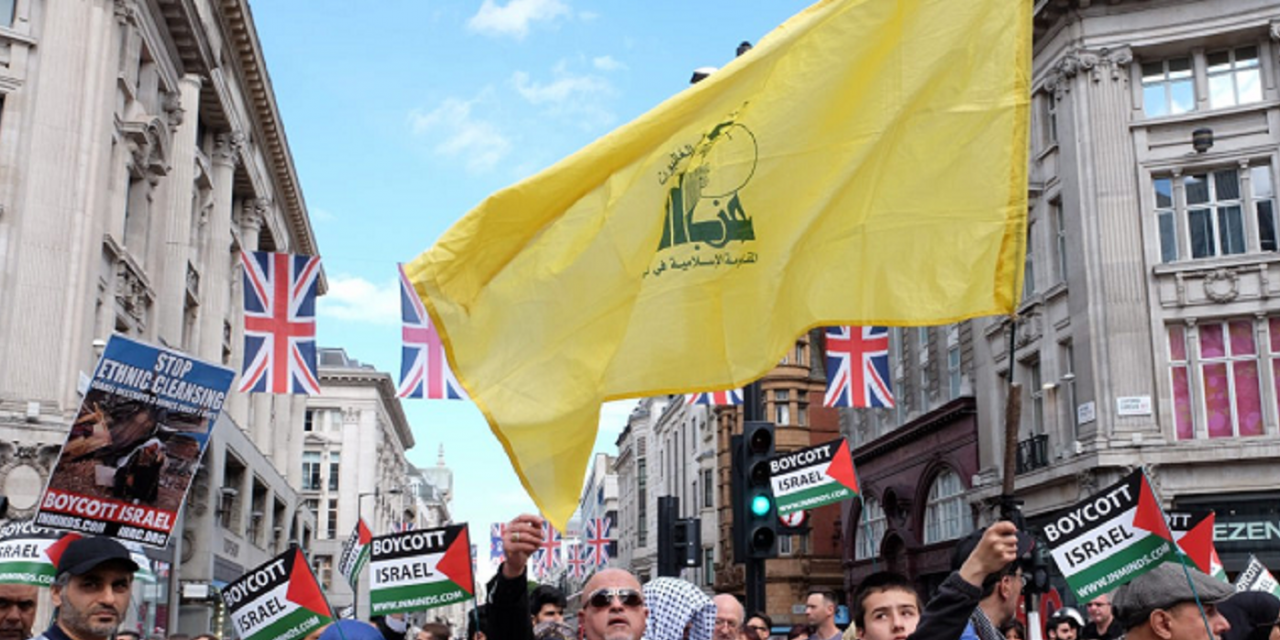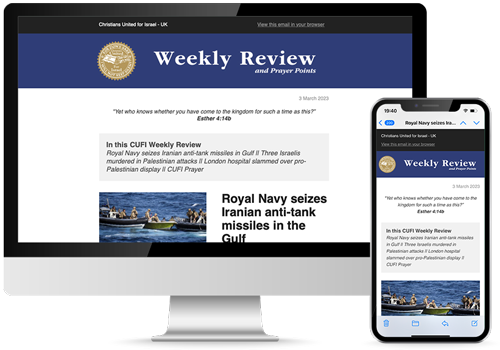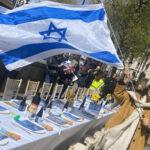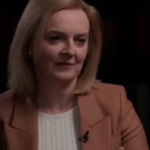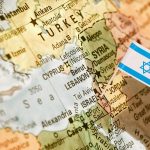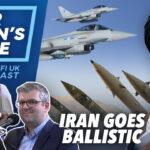On Sunday 10 June the flag of Hezbollah will be flown during an Al Quds Day march in London. The flag will be allowed by London police because the UK has banned Hezbollah’s military wing, but has not done so for its political wing. However, by their own admission the political and military operations of the Shi’a organisation are one and the same.
A closer look at the flag itself reminds us that this terrorist organisation represents an ideology that should not be promoted on our streets.
The flag of Hezbollah, while sometimes found in different colours, is usually composed of the green logo upon a yellow background with text above and below the logo in red (or sometimes green).
The logo is a stylised representation of the Arabic words حزب الله ḥizbu-llāh (meaning “Party of Allah”) in Kufic script. The letter “A” of “Allah” is linked to the upraised arm grasping an AK-47 assault rifle, which signifies the ideological legitimisation of the movement’s militancy as being divinely sanctioned.
The arm grasping the rifle signifies the martyrdom of Imam Husayn, who is the grandson of the Muslim prophet Mohammed, and links it to the militancy of the movement today, a poignant reminder that Hezbollah’s so-called political motives are intrinsically tied with its militant mission.
The logo also incorporates several other objects, namely a globe, a book, a sword, and a seven-leafed branch.
The globe represents Hezbollah’s desire to see its Islamic ideology ultimately prevail throughout the world.
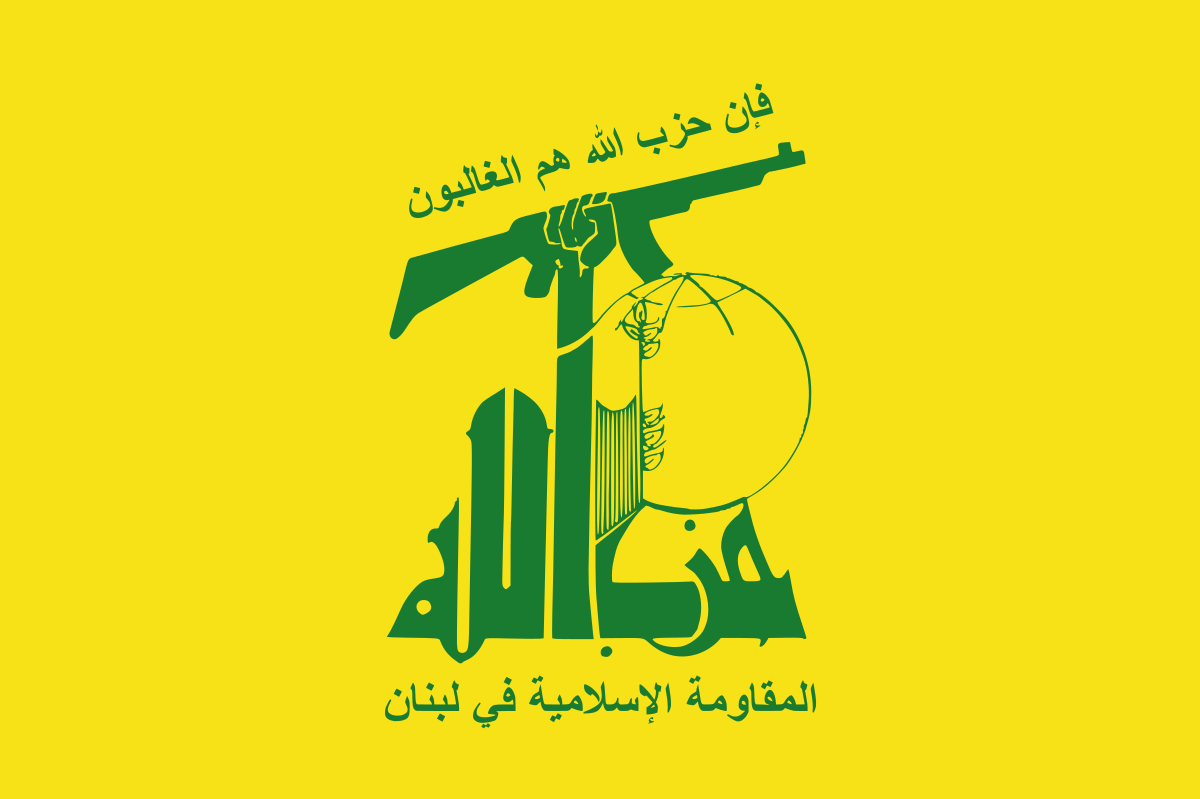
A Qur’an rests atop the letter “b” of the word “Hizb” (party) which is fashioned in the shape of a traditional lectern for the Muslim scriptures, which also signifies that the movement’s stances are legitimized and based upon the Qur’an. Emblazoned above the symbol of the movement is the Qur’anic verse, “Fa-inna Hizb Allah hum al-ghalibun,” “Lo, the Party of Allah, they are the victorious ones.”
The text above the logo reads فإن حزب الله هم الغالبون and means “Then surely the party of Allah are they that shall be triumphant” (Quran 5:56), which is a reference to the name of the party. Underneath the logo are the words المقاومة الإسلامية في لبنان meaning “The Islamic Resistance in Lebanon”.
The symbolism of Hezbollah’s flag points to the Islamic Revolution that was inspired and encouraged by the Ayatollah Khomeini subsequent to Iran’s 1979 Islamic Revolution. Its purpose is to export the Islamic Revolution throughout the world.
Hezbollah’s ideology is delineated in an official forty-eight-page manifesto that was published in February 1985 entitled, “Open Letter from Hezbullah to the Downtrodden in Lebanon and the World.” In the manifesto, Hezbollah echoed the anti-U.S. ideology of the Ayatollah Khomeini by declaring, “We are headed for dealing with evil at the roots—and the roots are America.”
Demonstrating its fealty to continuing the Islamic Revolution of Iran, Hezbollah designated the Ayatollah Khomeini as the Shi`i Faqih, or Supreme Religious Guide, and described the Islamic Revolution as the “vanguard” that “laid the foundation of a pan-Islamic state under the wise guidance of the fully qualified Faqih, Ayatollah Ruhallah Khomeini. The thoughts of Khomeini are taught at Hezbollah schools and indoctrination classes. Each year thousands of Hezbollah activists [go] on a visit to the tomb of Khomeini near Tehran.

Hezbollah legitimizes its terror activities and suicide bombings by relying on a radicalised interpretation of a core episode in Shi`i Muslim history. In 680 AD, Imam Husayn, the grandson of the Muslim prophet Muhammad. Followers of Hezbollah and the ideology of Ayatollah Khomeini paint Husayn as being a willing martyr and interpret this episode of their history as being the template for the Hezbollah suicide bombers of today. Hezbollah’s worldview is fueled by the perception that the Muslim world is experiencing a period of deep crisis and, as a result, members of the organization are encouraged to strike at the forces of evil in the world in order to accelerate a final apocalyptic confrontation between Muslims, who are characterized as the force of God in the world, and the West, which is characterized as the force of evil. From Hezbullah’s perspective, each of its terror attacks against the West is counted as an earthly action that assists the divine struggle against the Satanic forces of the world, personified by the West.
As the Iranian political analyst Amir Taheri notes:
“The Party of Allah’s ideology is simplicity itself, and it is therefore immediately accessible to the audience it favors above all: the illiterate poor in the towns and cities. This ideology, despite its Islamic pretensions, is in fact Manichean and is based on the division of all phenomena into good and evil. Mankind is also divided between the Partisans of Allah and those who support shaytan or Satan; the war between the two must continue until the complete victory of the Partisans of Allah. Every aspect of Satan’s presence must be removed, by violence if necessary, so that Divine society can become a reality.”
The Obligation to War and Jihad Hezbollah anticipates that the final cumulative effect of its war against the West will bring about the establishment of a radical transnational Islamic state that, in time, will encompass the entire world. Ayatollah Khomeini delineated his vision of a radical Islamic state achieving such a goal in a tract that he wrote in 1942 entitled Kashf Al-Asrar (“Keys to the Secrets”).
Khomeini explained:
“There are two kinds of war in Islam: one is called jihad [holy war], which means the conquest of [other] countries in accordance with certain conditions. The other [type] is war to preserve the independence of the [Muslim] country and the repulsion of foreigners. Jihad, or holy war, which is for the conquest of [other] countries and kingdoms, becomes incumbent after the formation of the Islamic state in the presence of the Imam or in accordance with his command. Then Islam makes it incumbent upon all adult males, provided they are not disabled and incapacitated, to prepare themselves for the conquest of [other] countries so that the writ of Islam is obeyed in every country in the world.”
In an effort to explain the benefits of his vision of the eventual domination of radical Islam throughout the world, Khomeini asserted: “But world public opinion should know that Islamic conquest is not the same as conquests made by other rulers of the world. The latter want to conquer the world for their own personal profit, whereas Islam’s conquest is aimed at serving the interests of the inhabitants of the globe as a whole. [Non-Islamic] conquerors want to rule the world so that they can spread through it every injustice and sexual indecency, whereas Islam wants to conquer the world in order to promote spiritual values, and to prepare mankind for justice and Divine rule. [Non-Islamic] conquerors sacrifice the lives and possessions of the people to their own leisure and pleasure. But Islam does not allow its leaders and generals to enjoy themselves or to have a moment’s leisure; in this way the lives and property of people can be protected and the bases of injustice destroyed in the world.”
Khomeini further justified the conquest of the entire world through jihad, or holy war, by explaining that the countries that will be conquered and ruled by radical Islam will be “marked for everlasting salvation”:
“Islam’s Holy War is a struggle against idolatry, sexual deviation, plunder, repression, and cruelty. The war waged by [non-Islamic] conquerors, however, aims at promoting lust and animal pleasures. They care not if all countries are wiped out and many families left homeless. But those who study Islamic Holy War [jihad] will understand why Islam wants to conquer the whole world. All the countries conquered by Islam or to be conquered in the future will be marked for everlasting salvation. For they shall live under Light Celestial Law.”
Hezbollah’s perpetuation of this ideology has resulted in a twenty-year history of attacks against Westerners, Israel, and Jews. The movement’s “spiritual mentor” is currently Shaykh Muhammad Husayn Fadlallah, and its secretary general is Shaykh Hassan Nasrallah. Over the past decade, Hezbollah has expanded its terror attacks against Israelis and Jews from the Middle East throughout the world. Hezbollah ultimately seeks to eradicate Western influence and promotes the cause of a Khomeinistyle Islamic revolution throughout the Middle East, and, ultimately, the world.
Their flag should not be paraded in London’s streets.
Recommended reading: Terrorism briefing Hezbollah by Yehudit Barsky (American Jewish Committee, 2003) has been sourced for parts of this article. Click here to download and read the complete analysis

